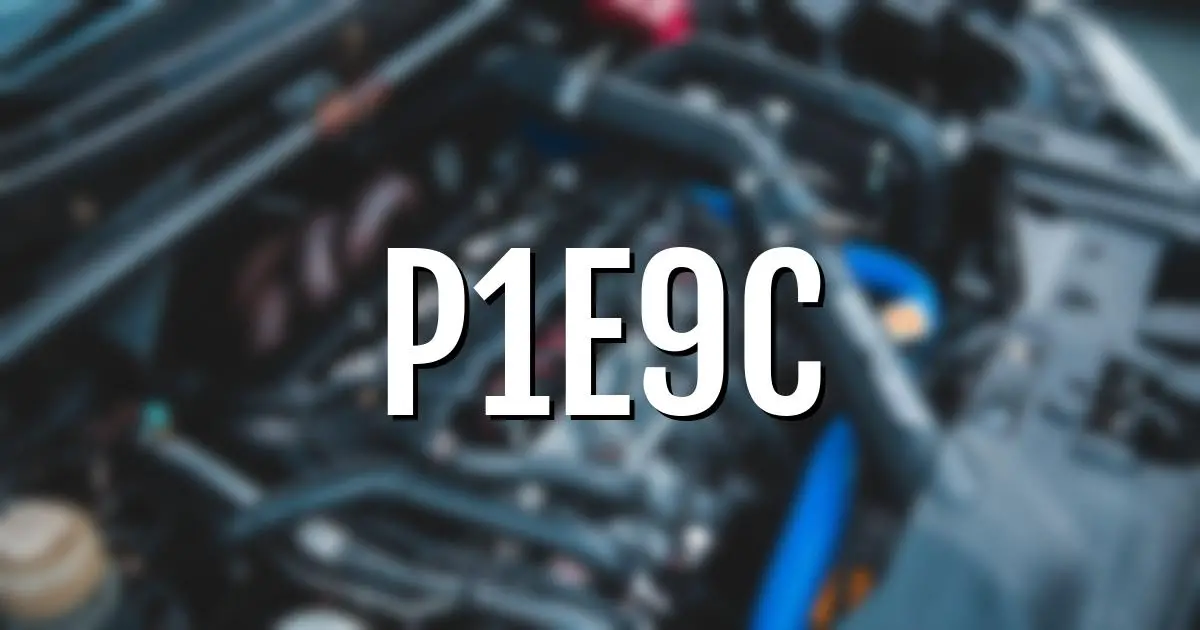If you see the engine light on or the service engine soon warning light, it could be due to a fault code P1E9C. This code indicates a problem with the HybridEV Battery Interface Control Module 3, which could be caused by an open or shorted harness or poor electrical connection. It’s important to address this issue promptly as it could affect the performance of your vehicle.
The repair time for this fault code is estimated at 1.0, and the fix involves visually inspecting the wiring harness and connectors for any damage or corrosion. To interpret the fault code, check the possible causes listed above.
| Repair Importance Level | 10.0 (Out of 10) |
| Estimated Repair Time | Approximately 1.0 hour |
| Repair Difficulty Level | 10.0 (Out of 10) |
P1E9C: Uncovering The Symptoms Of This Auto Fault Code
If you notice the Engine Light ON, it could be a sign of p1e9c fault code. Here are the symptoms to look out for:
- The P1E9C fault code in automobiles can cause several symptoms, including the engine light turning on or the service engine soon warning light appearing.
- Other symptoms may include reduced engine power, decreased fuel efficiency, rough idling, stalling, and difficulty starting the engine.
- Additionally, the vehicle may experience transmission shifting problems, and the speedometer may not function correctly.
- It is essential to address these symptoms promptly to prevent further damage to the vehicle and ensure safe driving conditions.
Decoding P1E9C: Common Causes Of This Fault Code
The P1E9C fault code can be caused by a faulty control module, open or shorted harness, or poor electrical connection.
- The automobile fault code P1E9C can be caused by a faulty Hybrid/EV Battery Interface Control Module 3.
- It can also be caused by an open or shorted Hybrid/EV Battery Interface Control Module 3 harness.
- Additionally, a poor electrical connection in the Hybrid/EV Battery Interface Control Module 3 circuit can also trigger this fault code.
Fix Code P1E9C: Simple Steps To Get Your Car Running
Below are the possible fixes for the automobile fault code p1e9c, including inspecting wiring harness and connectors for damage or corrosion.
- To fix the automobile fault code p1e9c, first, check the possible causes listed above.
- Then, visually inspect the related wiring harness and connectors.
- Look for damaged components and check for broken, bent, pushed out, or corroded connector’s pins.
- This fix will take an estimated repair time of 1.0 hour.
Crunching The Numbers: P1E9C Fixing Cost & Complexity
The fault code P1E9C is a diagnostic trouble code related to the hybrid battery pack.
The code indicates a problem with the battery pack’s cooling system. The estimated repair time for this issue is 1.0 hour. The cost of fixing this issue can vary depending on the auto repair shop, but it is common for most shops to charge between $75 and $150 per hour.
It is important to address this issue promptly to prevent further damage to the battery pack and ensure the vehicle’s optimal performance.
P1E9C: Understanding The Elusive Hybrid Battery Voltage Sensor Fault
The P1E9C fault code is related to the hybrid battery interface control module 3. This fault code is triggered when the module detects a fault condition within its own internal microprocessor integrity.
The fault is internal to the module and does not involve any external circuits. The code specifically refers to a read-only memory performance issue within the hybridEV battery interface control module 3.
If this fault code is detected, it is important to have the module diagnosed and repaired by a qualified technician to ensure proper functioning of the hybridEV system.
FAQ
If you’re experiencing the P1E9C fault code in your automobile, it could be due to a faulty Hybrid/EV Battery Interface Control Module 3, an open or shorted harness, or a poor electrical connection in the circuit. The engine light or service engine soon warning light may also turn on. To fix the issue, inspect the wiring harness and connectors for any damage or corrosion, and check for broken or bent pins.
If you’re experiencing an Engine Light ON (or Service Engine Soon Warning Light) due to a faulty Hybrid/EV Battery Interface Control Module 3, you can visually inspect the related wiring harness and connectors to fix the issue. Check for damaged components and look for broken, bent, pushed out, or corroded connector’s pins. This will help you identify if the Hybrid/EV Battery Interface Control Module 3 harness is open or shorted, or if the circuit has a poor electrical connection.
If you find damaged components or broken, bent, pushed out, or corroded connector’s pins while inspecting the wiring harness and connectors, follow these steps. First, check the “Possible Causes” listed above. Then, visually inspect the related wiring harness and connectors. Finally, look for damaged components and check for broken, bent, pushed out, or corroded connector’s pins. This will help fix the issue of the Engine Light ON (or Service Engine Soon Warning Light) caused by a faulty Hybrid/EV Battery Interface Control Module 3, an open or shorted Hybrid/EV Battery Interface Control Module 3 harness, or a Hybrid/EV Battery Interface Control Module 3 circuit poor electrical connection.

Wrap Up
If your engine light is on, it may be due to a faulty HybridEV Battery Interface Control Module 3.
Check the wiring harness and connectors for damage, and inspect the pins for any issues. Take action to fix any problems found.

